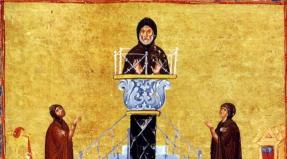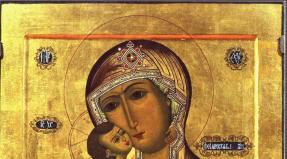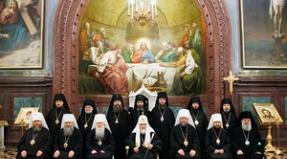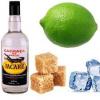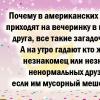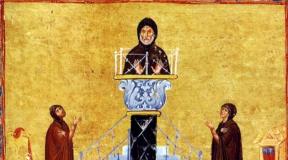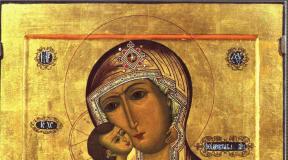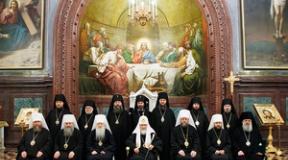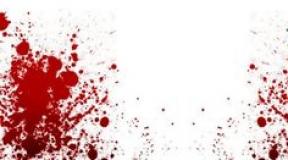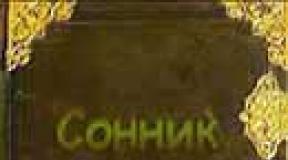Why do they give orders and medals? What are orders given for? Highest awards giving the owner special status
Why were they given a medal for courage, and what kind of medal is it?
- The Medal for Courage was established by the Decree of the Presidium of the Supreme Soviet of the USSR on October 17, 1938. The Regulations on the medal say: The Medal of Courage was established to reward personal courage and bravery demonstrated in the defense of the socialist Fatherland and the performance of military duty. The Medal of Courage is awarded to military personnel of the Red Army, Navy, border and internal troops and other citizens of the USSR.
Before the start of the Great Patriotic War, about 26,000 military personnel were awarded the medal for courage and bravery in defending the state borders of the USSR and in the Soviet-Finnish War. During the Great Patriotic War, more than 4 million awards were made between 1941 and 1945. At the same time, a medal was established for military merit, which was also awarded to military personnel and civilians who, in the fight against the enemies of the Soviet state, contributed to the success of military operations at the front with their skillful, proactive and courageous actions, involving the risk of their lives. In fact, these were the first Soviet medals, not counting the anniversary medal established somewhat earlier for the 20th anniversary of the Workers' and Peasants' Red Army.
The Medal for Courage is silver in color and has the shape of a circle with a diameter of 37 mm with a convex edge on both sides. On the front side of the medal at the top there are three flying airplanes. Under the planes there is an inscription in two lines For courage, red enamel is applied to the letters. Under the inscription is a T-35 tank. At the bottom of the medal is the inscription USSR, covered in red enamel. On the reverse (back side) is the medal number. The medal is attached with a ring to a pentagonal block covered with silk moiré ribbon. Gray ribbon with two longitudinal blue stripes along the edges, ribbon width 24 mm. The width of the strips is 2 mm. Initially, the Medal for Courage was attached to a rectangular block covered with a red ribbon.
This award was the highest medal of the USSR and remained so until the collapse of the Soviet Union. Fortunately, the Medal for Courage has not become solely a historical relic, like many other orders and medals of the Soviet period. The Medal for Courage was established in the system of Russian state awards by Decree of the President of the Russian Federation of March 2, 1994 No. 442 (as amended by Decree of June 1, 1995 No. 554). And the appearance of the medal did not undergo virtually any changes, only the inscription USSR on the obverse (front side) was removed. The diameter of the medal decreased slightly to 34 mm. The main condition for the award continued to be personal courage and bravery, just as it was originally stated in the Regulations on the medal. Nowadays, the silver medal for courage can be awarded to military personnel, employees of internal affairs bodies, and other citizens of Russia and for courage and bravery shown in battles, and when performing special tasks to ensure state security, while protecting the constitutional rights of citizens in conditions involving risk to life.
Education
Why was the medal “For Courage” given? Military orders and medals of the Soviet Union
July 30, 2015This medal is considered more honorable than all others. It was received mainly by privates, foremen and sergeants, although the statute does not prohibit it from being awarded to officers. It just so happened that, unlike other medals, which could be obtained simply by taking part in some large-scale front-line operation, this one was given for very specific heroic actions, which, in the opinion of the command of the military unit, for some reason were before the order “ didn't make it." There will be a short story for the reader’s attention about why the medal “For Courage” was given and what the history of this government award is.
New award, 1938
At the end of the thirties, Soviet Red Army soldiers already had to fight with various opponents. Some of them managed to take part in the Spanish Civil War, meeting the fascists for the first time. It fell to the lot of others to fight the Japanese militarists who were trying to dislodge the position of the Soviet country in the Far East. It was restless on the outer borders - groups of saboteurs and spies tried to infiltrate there. Border guards often died and were injured while performing their military duty. There is a need for a new award, prestigious enough to recognize the outstanding courageous actions of the Red Army and Navy. In the fall of 1938, a sketch of a medal was approved with a motto written on its front side, eloquently (the letters are large and really red) saying what exactly it would be awarded for. There are other details in the image, but the main thing is the inscription. It was designed so that descendants would not have questions about why the medal “For Courage” was given. To understand, just read.

Other design elements
The front side reflects the general aesthetics of the time when the award sample was adopted. The T-35 tank was considered the most powerful Soviet ground weapon, it was multi-turreted and very heavy, so it found its place on the obverse. It was used quite rarely during the Winter Campaign on the Karelian Isthmus, was not used at all at Khalkhin Gol and proved its ineffectiveness in the first months of the Great Patriotic War, but even after that it was not changed to the “thirty-four”, IS or KV.
Three planes are also visible above, similar in silhouette to the I-16. These vehicles also left the Red Army aviation in 1941, but managed to fight for some time. Viktor Talalikhin made the ram that made him famous on this one.

At the bottom of the award, the nationality of the insignia is indicated: USSR, and in the center, in large ruby-red enamel letters, it is written what the medal was given for. For courage. That is, for selfless courage.
Only the copy number is stamped on the smooth reverse side.

Material of manufacture
The medal is cast from highly purified silver, corresponding to 925 standard. This means that the proportion of impurities in the alloy is only seven and a half percent. The weight of the award varied, depending on the year of production, from 27.9 to 25.8 grams. The permissible deviation from the norm when casting the workpiece also changed (from one and a half to 1.3 grams). The medal is quite large, its diameter is 37 mm. The recesses of the inscriptions “For Courage” and “USSR” were filled with enamel, which hardened after firing. On many copies it peeled off due to mechanical stress; the soldiers wore the awards for many years, they were covered with scratches and other damage. It happened that they saved a soldier’s life. The shot that deflected the fatal bullet explained without any words why the medal “For Courage” was given.

Execution options
The initial sketch implied a rectangular shape of a pendant block of small dimensions (25 x 15 mm), to which the medal was attached with a ring threaded into the eye, also quadrangular. Silk ribbon, moire, red. It was fixed on clothing using a round nut on a threaded pin.
The medal “For Courage” of 1943 and later years of issue was brought into line with the traditions and standards of state awards that had developed in the USSR. The eyelet became round, and the last was pentagonal; it was equipped with a pin. The color of the ribbon was also changed (to gray with two blue stripes) to make it easier to distinguish on the order bars.

The first gentlemen
The list of those awarded the medal “For Courage” since its establishment has long exceeded four million. And this despite the fact that there was an unspoken rule in relation to her - to honor only desperate daredevils who had truly accomplished something special. And the border guards were the first to receive it, there were two of them.
History is silent about who received the first medal “For Courage” - F. Grigoriev or N. Gulyaev, although this can be found out by finding copies of award sheets in the archive. But this, in essence, does not matter, because both of them became heroes at the same time, detaining a sabotage group in the area of Lake Khasan that was trying to enter the country from adjacent territory.

Pre-war period
Then there was the Finnish Winter War, during which the Red Army had a very difficult time. One can assess her character differently from a political point of view, but heroism and the ability to self-sacrifice were undoubtedly demonstrated by Soviet soldiers. In the conditions of the Arctic winter, terrible frosts and polar night, the Red Army stormed the super-fortified defensive line of Mannerheim, breaking through several echelons of fortifications. The list of those awarded the medal “For Courage” in the so-called “pre-war” period reached 26 thousand soldiers who proudly wore it on the left side of their chest.

War
There was no test in the history of our country more severe than the Great Patriotic War. In its first months, few awards were given out. But soon heroism assumed such a widespread character that it required visible official recognition. One of the most common was the medal “For Courage”. The year 1941 went down in history as the date of the victory near Moscow and many other difficult and bloody battles that did not always lead to success. The medal was awarded to many then - soldiers, nurses, snipers, intelligence officers, men and women, and even fighters of penal battalions, who, in order to do this, had to do something for which others were entitled to the high title of Hero. It did not go to those who settled in “non-dusty” positions, even if they had very good relations with their superiors. Such a person could receive another medal, also a very serious one, for example “For Military Merit” (“services” - real front-line soldiers insultingly teased in such cases). Recipients of the medal “For Courage” looked like real heroes in the eyes of their relatives and citizens they simply met on the street. The prestige of the award was not in doubt.
Sometimes a fighter was awarded it multiple times. It is difficult to explain this, because there are other awards - orders, for example. Most likely, there was the usual front-line confusion.

Nowadays
There were plenty of reasons to show courage during the Afghan War and other regional conflicts of the late 20th century in which our soldiers took part.
This medal became so beloved and respected by the people that they did not want to give it up even after Russia gained independence. In 1992, her rights were restored, although the letters USSR disappeared from the obverse. The recipients of the medal “For Courage,” our contemporaries, received it for the same thing as our glorious ancestors. All explanations are written on it in large red letters. Real brave men who defend their Motherland in the very difficult situation that has developed in the world today do not like to talk about their exploits. In this, as in many other things, they are similar to World War II veterans. The military awards worn on holidays speak for them.
There is a medal “For Courage” in Belarus. Well, common Victory, and common rewards.
What is an order? This is an honorary distinction that the state issues to people who have significant personal merit in a particular area. Let's look at what exactly orders are given for in modern Russia.
Order of "Parental Glory"
The order is awarded to people who have raised at least seven of their own or adopted children. The condition is to ensure a healthy lifestyle, proper care for children, their education and development.
Order of St. Andrew the First-Called Apostle
Awarded for outstanding services contributing to the prosperity and glory of Russia. To understand what needs to be done to receive the order, let's look at the list of recipients. There are only 16 of them. Among them are great writers and poets (A. I. Solzhenitsyn. R. G. Gamzatov, M. S. Mikhalkov. D. I. Granin), scientists and inventors (D. S. Likhachev, M. T. Kalashnikov), political and religious figures (M. S. Gorbachev, Alexy II).
Order of St. George
It is awarded to senior and senior officers who took part in military operations against an external enemy. Military operations must end in the defeat of the enemy, contribute to the development of military science and become an example to follow for subsequent generations.
Order "For Merit to the Fatherland"
This distinction is awarded to those who have made a significant contribution to the development of Russian statehood, economy, science, culture, art, sports, and peaceful coexistence between different nations.
Order of the Holy Great Martyr Catherine
Awarded for contributions to the development of peaceful relations, charitable activities, humanitarian missions, and the preservation of cultural wealth. Among the recipients are a doctor, a foster parent and the abbess of the monastery.
Order of Alexander Nevsky
It is awarded to citizens, mostly holding government positions, for their contribution to the development of production, science, culture, and education. Among the recipients are deputies of the State Duma and the Federation Council, high-ranking officials, governors, and directors of large enterprises.
Order of Suvorov
The Order can be awarded to major military leaders and entire military formations that defeated an enemy superior in numbers and technical support in ground and air operations. The quality of combat training of military units, courage and maintenance of combat effectiveness are assessed.
Order of Ushakov
Awarded to the command of naval units for organizing successful operations against a superior enemy in numbers, resulting in the destruction of the enemy fleet, as well as for demonstrating initiative, determination and military skill during offensive or defensive operations at sea.
Order of Zhukov
Awarded to the highest command staff of the army for conducting skillful combat operations on the scale of large groupings of troops (for breaking through the enemy’s defense line, completely destroying the enemy, perseverance in containing superior forces of the advancing enemy).
Order of Kutuzov
It can be received by commanders of military units, as well as battalions and companies. It is necessary to prove oneself in skillful conduct of offensive or defensive combat operations, to have personal courage and courage.
Order of Nakhimov
Awarded for the successful and skillful organization of combat operations at sea, including the conduct of amphibious and anti-landing operations, and for personal courage and bravery demonstrated during battles.
Order of Courage
The award is given to those who have shown courage in saving people during natural disasters, catastrophes, clashes with crime, and other extraordinary situations that pose a threat to life.
Order of Military Merit
To receive the order, you must conscientiously and exemplarily serve in the army as an officer for more than 20 years.
Order "For Naval Merit"
To receive the order, you need to make a personal contribution to the exploration and use of maritime spaces in order to strengthen Russia's defense capability or its economic potential.
Order of Honor
The award is given to citizens whose activities in the government, scientific, social, cultural or charitable spheres have significantly improved the quality of life of other people.
Order of Friendship
Awarded for work to strengthen mutual understanding and good neighborly relations between different nationalities, contribution to the mutual enrichment of cultures of different peoples, and the implementation of international economic and investment projects.
The Order of Merit for the Fatherland became the first highest award in the new Russian state after the collapse of the USSR. The award was made for services in strengthening the state, developing the socio-economic sphere, strengthening defense capabilities and international cooperation, as well as for services in sports, culture, art and science.
A little history
The Order of Merit for the Fatherland has its roots in the 18th century. This connection can be seen in the motto “Benefit, Honor and Glory” on the award. Under the same motto, in 1782, Empress Catherine the Great introduced the Order of St. Vladimir, which had 4 degrees (the first was considered the highest). The award was timed to coincide with the 20th anniversary of the empress's reign.
"St. Vladimir" was awarded to both military and civilians. At the same time, there was a sequence in his awarding. In 1789, the order of the fourth degree, issued for exploits, received a distinctive feature: a red and black bow.
The Order of Merit for the Fatherland was introduced in March 1994.
Thus, the state began to establish legal order in the existing confusion regarding awards that arose as a result of the collapse of the USSR.
The award continued the tradition of “St. Vladimir”: it has the same motto, four degrees, priority in awarding (the fourth degree is awarded first), the distinction of a military order in the form of crossed swords.
Subsequently, the award system was improved, and the statute of the order was supplemented with some changes. The first award of the highest degree was awarded to Jacques Chirac, the President of France, in 1997. Order No. 1 was awarded in June 2001 to Russian President Boris Yeltsin. It is interesting that only Chirac, Yeltsin and Kuchma (President of Ukraine) were awarded the first degree of the order, without receiving lower degrees. The highest degree of award was awarded to the head of the Russian Orthodox Church Alexy II in 2004. In 1997, the patriarch was awarded the 2nd degree of the order.
What is the order given for?
The award “For Services to the Fatherland” recognizes individuals who have made a significant contribution to various areas of activity of the state and society. First of all, it is awarded for merits in the development of statehood. It is this question that is most important for the new state, the new community of the Russian Federation, because statehood characterizes the state of this community and the paths of its development. That is, a person who has outstanding merit in pursuing a strong national policy aimed at territorial unity deserves the order.
This award can be awarded to individuals who have contributed to the cause of peace and good neighborliness between countries and peoples, since only peace can contribute to the development of a state. Outstanding achievements in work can also be awarded the order. The concept of “work” can mean achievements in science, art, culture and sports. Therefore, high performance in these areas of activity can be recognized with this award. The Order is also awarded for significant contributions to strengthening the defense capability of the Russian Federation, protecting its borders, law and order.
Statute
In 2010, the award system in the Russian Federation was improved. According to the latest edition of the statute, the award has 4 degrees. The first is the highest. The awarding is carried out starting from the lowest, while the recipient of the order for the first time must have the medal “For Services to the Fatherland”. The exceptions are:
- Heroes of Russia;
- Heroes of Labor of the Russian Federation;
- Heroes of the Soviet Union;
- Heroes of social labor.
Citizens who have the title “national” and the order also fall under the exception:
- Ushakova;
- Alexander Nevsky;
- Suvorov;
- St. George.
Also, the President of the Russian Federation may decide to award the order to a person who has not previously had state awards of the Russian Federation. When a person is awarded the highest degree, the Order of Merit for the Fatherland, 2nd degree, is no longer worn. On other similar occasions, a sign or ribbon of a higher grade must be worn. An exception is the badge of the order issued for military merit (with swords).
Each award, depending on the degree, has features in appearance.
The ceremony of awarding the Order of the 1st and 2nd degree is held twice a year: December 12 and June 12.

Description of the award sign
The Order of Merit for the Fatherland, 1st class, includes a badge and a star. The same applies to the order of the second degree. The third and fourth degrees have only a sign.

The order badge of all degrees is made of silver and plated with gold. It is a symmetrical cross with widened ends. The front part of the ruby-colored cross is covered with enamel.
The signs of each degree differ from each other:
- 1st degree – cross with 60 mm between ends;
- 2nd and 3rd degrees - a cross with 50 mm between the ends.
The Order of Merit for the Fatherland, 4th class, has the smallest sign: 40 mm between its ends.
In addition, the badge of the order, awarded for merits in military operations, has two crossed swords covered with gold. Each sword is 28mm long and 3mm wide. In the center of the front side is the State Emblem of the Russian Federation.

On the reverse side of the badge there is a medallion on which the motto of the award and the date of its establishment (1994) are stamped. The lower part of the medallion is framed by laurel branches. At the lower end of the cross is the sign number.

The Order of Merit for the Fatherland, 4th class, has a miniature copy of the badge, which is worn on a pentagonal block. The length of the cross is 15.4 mm.
Description of the star
The award star is made of silver without gilding. It has eight polished beams - shtralov. In the center of the front side there is a medallion with a gilded image of the coat of arms of the Russian Federation, framed by the motto of the order on a red field covered with enamel.

The star “For Services to the Fatherland” of the 2nd degree differs from the star of the order of the highest degree in the length of the rays: the 2nd degree has rays 72 mm long, and the 1st degree - 82 mm.
The star is attached to clothing with a pin.
Order of wearing the order
The statute of the order determines the order of its wearing for each degree.
The highest degree (first) is worn:
- star - on the left side of the chest;
- the sign is on a shoulder strip running from right to left, 10 cm wide.

The second degree is worn:
- star - on the left side of the chest;
- sign - on a ribbon passing through the neck, 45 mm wide;

The third degree of the badge is worn similarly to the 1st degree badge, but the ribbon is 24 mm wide.
The badge of the lowest degree is located on the block on the left side of the chest in front of the other orders and medals.
If there is an order of the highest degree, the order of the lower degrees, the medal “For Services to the Fatherland” should not be worn. The exception is signs with crossed swords.
There are some features of wearing the award by military and civilians. For example, the ribbon of an order received for military merits is attached using a bar. If the recipient has already been awarded the Order of St. George, then in this case his ribbon is worn first, only then the ribbon of the sign of the order in question.
Full Knights of the Order
Over the 22 years of the order’s existence, more than twenty people received the full award set of the Order of Merit for the Fatherland. First of all, these are prominent figures in politics, science, art and culture.
Full holders of the order include:
- Viktor Chernomyrdin - head of the first government of Russia;
- Mintimer Shaimiev - former president of Tatarstan;
- Valentina Matvienko – Speaker of the Federation Council of Russia;
- Sergei Lavrov – head of the Russian Foreign Ministry;
- Zhores Alferov – physicist, Nobel laureate;
- Leonid Bronevoy – theater and film actor;
- Galina Vishnevskaya – opera soloist;
- Maya Plisetskaya - ballerina.
Benefits for those awarded the order
The status of a high state award implies certain social and material privileges for the owners of the order. Persons awarded the order of the same name for services to the Fatherland receive monthly additional monetary support from the state budget, the amount of which depends on the degree of the order received.
The recipient of the highest order will receive 415% of the basic component of the old-age pension. 330% will be received by persons awarded the order of the second or third degree.
Security is not provided for working holders of the order. The right to it, as well as to other benefits, begins only upon retirement from old age.
In addition, the benefits of the Order of Merit for the Fatherland include:
- use of medical services at the expense of the state budget or compulsory health insurance in the clinics to which the awardee is attached;
- free medical care in government health care institutions;
- free dental prosthetics, except for the cost of material, in government health care institutions;
- annual leave (labor) at a time convenient for the order bearer, as well as leave without pay for up to thirty working days throughout the year;
- free use of transport (except taxis) in any city in the country, as well as travel in intercity vehicles;
- 50% discount on utility bills and housing.
Other benefits are also provided for persons awarded the Order of Merit for the Fatherland.
Meaning
The status of a high state award, which is presented personally by the head of state in the Kremlin, in the Catherine Hall, is a serious incentive to continue activities for the benefit of one’s Fatherland. In fact, the state officially recognizes the merits of its citizens in the development of statehood, the socio-economic sphere, and defense capability.
